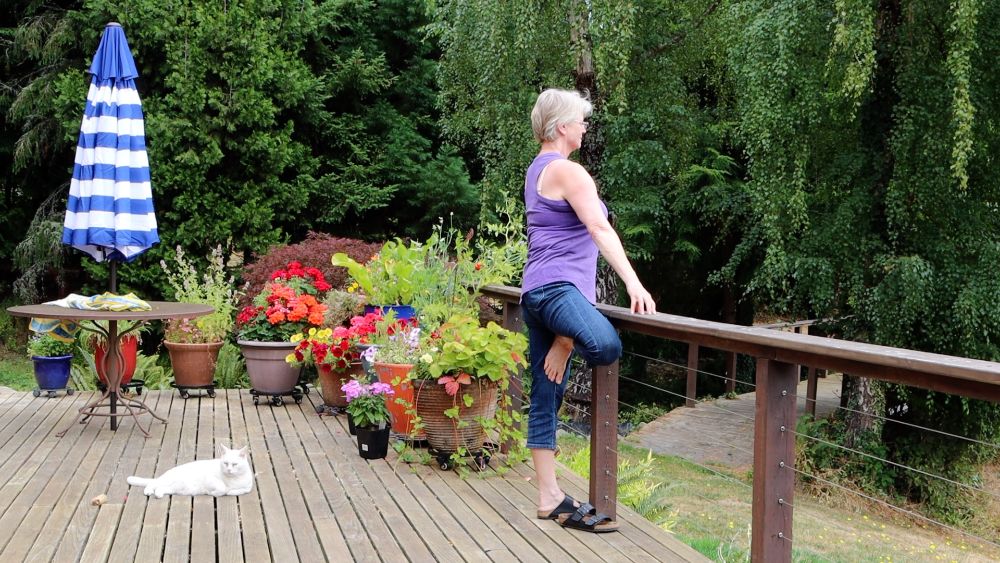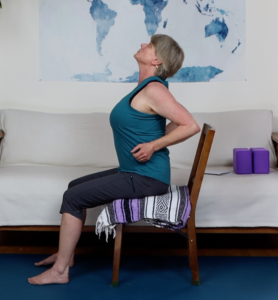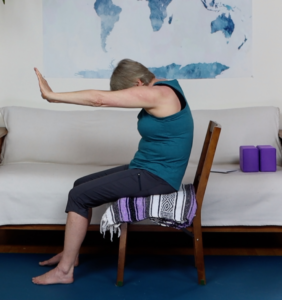
Before total hip replacement our bodies are often limited in the kinds of movement they able to do. It can be difficult, if not impossible, to get down on the floor, to balance, or to bend like we did before the THR journey started. Following THR surgery, your surgeon may prescribe limits on your movement while bone and tissue heal. Consider these transitional times as an opportunity to investigate the more contemplative aspects of yoga and also to get inventive with props and asanas.
When you are in pain, frustrated, or stressed-out, turn to restorative yoga, pranayama (breathing practices), or to mindfulness practices. Studies show that the contemplative practices of yoga help with healing, with pain management, and with dealing with stress. You need very little in the way of props for these practices. You just need a comfortable quiet place to settle. This can be any peaceful place – your bed, your lounge chair, under a tree, or on a bench at the park. When you have a quiet moment let your mind turn toward the rhythm of your breath, or let it settle on any sensations you feel in your body. Watch with curiosity and non-judgement. Even a few minutes of mindful practice can make a difference in the way we process and respond to stressors like pain.
Get inventive with where and when you practice yoga poses. During the time before THR surgery and in the few weeks during recovery, you may not want to get down on the floor or face a full-on yoga practice. Insert a pose here and there in your everyday activities. Pick ones that are familiar to you and that are easy on your body. Remember that the benefits of yoga lie within your awareness of how you are practicing a pose, not within the difficulty of the pose. When you practice a posture, no matter the difficulty, with an attitude of curiosity, you are bringing your mind to a point of focus. This is yoga and you are tapping into its benefits!
-
- For hip strength and stability try doing Tree Pose while standing at your sink looking out the window or while you are on your deck taking in the sunset. Use your countertop or porch railing for stability and balance.
- Strengthen your hip stabilizing muscles by practicing Mountain Pose while waiting to check out at the grocery store or while standing at your sink.
- To limber your spine practice Cow and Cat on the edge of your of bed, seated in a chair, or on a bench at the park.
- To strengthen your back muscles and hamstrings, do practice Bridge pose / Setu Bandhasana before getting out of bed or on your couch.
- Practice a few twists while seated in a chair, your car, or recliner, sit up as tall as possible and use the armrests, seat, or dashboard, as leverage.
- Do some mindful walking while pushing the shopping cart or walking your dog. Observe the sensations in your feet, legs, and hips.
Give yourself permission to reinvent what your yoga practice looks like and take advantage of what the world off the mat has to offer.
Here’s to Healthy and Happy Hips!
Key Takeaways
- Yoga goes beyond the mat – You can practice yoga anywhere—at the kitchen sink, in bed, or even while grocery shopping—by incorporating mindful movement and breath awareness.
- Adapt and modify – Before and after total hip replacement, use props, adjust poses, and explore gentler forms of yoga like restorative yoga and breathing exercises.
- Mindfulness aids healing – Breathing techniques, meditation, and body awareness can help manage pain, reduce stress, and support overall recovery.
- Strength and stability matter – Simple standing poses like Tree Pose or Mountain Pose can improve hip strength and stability when practiced with support.
- Listen to your body – Healing takes time, so practice yoga with curiosity and awareness, focusing on movement that feels good rather than forcing difficult poses.
Frequently Asked Questions (FAQs)
Q. Can I practice yoga even if I can’t get on the floor? Absolutely! Practice yoga anywhere—sitting in a chair, standing at a counter, or even lying in bed. The key is mindful movement and breath awareness.
Q. How does yoga help with hip replacement recovery? Yoga strengthens hip stabilizers, improves mobility, reduces pain, and enhances mindfulness, all of which support a smoother recovery.
Q. What are some easy yoga poses I can do after hip surgery?
- Tree Pose (with hand support) for hip stability
- Mountain Pose while standing in line
- Seated Cat-Cow for spinal mobility
- Bridge Pose in bed for back and hamstring strength
- Seated twists in a chair for gentle spinal rotation
Q. How can mindfulness help with post-surgery pain? Mindful breathing and meditation can reduce stress, ease discomfort, and help you stay present in your recovery journey.
Q. When can I start yoga after total hip replacement? Always wait for clearance from your surgeon (typically 6-12 weeks post-surgery). Start with gentle movements and gradually progress as you heal.
Non-Members: Preview Yoga Basics, Preview Restoratives, Preview Standing Poses
Members view: Mountain Pose/Tadasana, Savasana, Supta Baddha Konasana, Mountain pose, Tree pose
Free video: Yoga while healing from Total Hip Replacement Surgery: A safe post-op asana practice
Become a member of Yoga for Hip Replacement here
Articles and Studies:
“This is your Brain on Mindfulness,” Shambhala Sun, Dr Michael Baime
How Does Yoga Relieve Chronic Pain?
Stretching and Flexibility: Physiology of Stretching
Go Slow – Build New Neural Pathways


